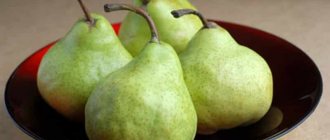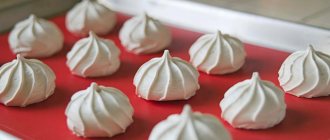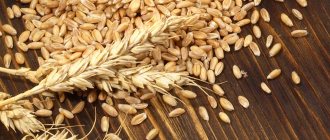For many, it will be a discovery that sherbet, known as an oriental sweet, is also a soft drink made from fruit juice with the addition of sugar, honey and other ingredients. In the understanding of Russians, sherbet is an aromatic sweet that resembles the consistency of candy, so we will talk about the composition and beneficial properties of this product. To prepare sherbet, various ingredients are used, giving it a unique taste and aroma. Meanwhile, it contains a large amount of sugar, so the question of how many calories are in sherbet worries many people with a sweet tooth, especially those who are used to counting calories.
Properties of sherbet
How much does sherbet cost (average price for 1 kg)?
Moscow and Moscow region.
190 rub.
The word sherbet or sherbet , as well as sorbet, has not only different spellings, but also several meanings. Firstly, sherbet refers to an ancient oriental vitamin drink based on rose hips, rose flowers, licorice and spices. Nowadays, sherbet is a soft drink made from the juices of fruits and berries, with the addition of sugar, honey, herbs and spices.
Secondly, to all those with a sweet tooth, sherbet is known as fruit ice cream or a fragrant oriental sweet delicacy. It’s the last type of sherbet that we want to introduce you to today. Sherbet received its distinctive name thanks to the Turkish language and the word Şerbet, which has analogues in other languages. For example, Persians, Urdu people and Arabs call sherbet sharbat.
Making sorbet with peanuts
To prepare sherbet fudge with peanuts, you will need the following ingredients: two glasses of milk, three glasses of sugar, 200 g of peanuts, 50 g of butter.
Pour the milk into a saucepan, add two and a half cups of sugar. Stir, then put on low heat and cook until you understand that the sugar has completely dissolved. Please note that the contents of the pan must be constantly stirred to prevent the milk from burning. After this, reduce the heat to low and wait until the milk begins to thicken and become creamy.
Pour the remaining sugar into a frying pan and melt it over very low heat. Carefully pour the melted sugar into the pan with the milk. Add pre-melted butter there and mix thoroughly.
Best materials of the month
- Coronaviruses: SARS-CoV-2 (COVID-19)
- Antibiotics for the prevention and treatment of COVID-19: how effective are they?
- The most common "office" diseases
- Does vodka kill coronavirus?
- How to stay alive on our roads?
Peel the roasted peanuts, chop them and add them to the sweet mixture. Mix thoroughly again, then pour the mixture into a baking dish and refrigerate for several hours. Cut into pieces before serving.
Composition of sherbet
In terms of its composition, sherbet is classified as a sweet, and according to its consumer and taste properties, the product is classified as candy. The composition of sherbet includes various products, which depend solely on the national recipe of the dish. However, in any case, sherbet will look like fudge to which various ingredients are added. For example, nuts, vanillin or raisins. Modern sherbet producers use condensed milk as the main sweetening ingredient.
The calorie content of sherbet will also depend on the original ingredients of the product. The average calorie content of sherbet is 417 Kcal per 100 grams of product. Agree, it’s quite a satisfying delicacy. Sherbet remains the most popular dessert in eastern countries. The most popular among Easterners is sherbet with peanuts or groundnuts, which are filled with condensed cream.
Calorie content of Sherbet. Chemical composition and nutritional value.
Nutritional value and chemical composition of "Sherbet".
The table shows the nutritional content (calories, proteins, fats, carbohydrates, vitamins and minerals) per 100 grams of edible portion.
| Nutrient | Quantity | Norm** | % of the norm in 100 g | % of the norm in 100 kcal | 100% normal |
| Calorie content | 140 kcal | 1684 kcal | 8.3% | 5.9% | 1203 g |
| Squirrels | 0.9 g | 76 g | 1.2% | 0.9% | 8444 g |
| Fats | 1 g | 56 g | 1.8% | 1.3% | 5600 g |
| Carbohydrates | 30.8 g | 219 g | 14.1% | 10.1% | 711 g |
| Alimentary fiber | 1.3 g | 20 g | 6.5% | 4.6% | 1538 g |
| Water | 66.1 g | 2273 g | 2.9% | 2.1% | 3439 g |
| Ash | 0.4 g | ~ | |||
| Vitamins | |||||
| Vitamin A, RE | 12 mcg | 900 mcg | 1.3% | 0.9% | 7500 g |
| Retinol | 0.012 mg | ~ | |||
| beta carotene | 0.001 mg | 5 mg | 500000 g | ||
| beta Cryptoxanthin | 5 mcg | ~ | |||
| Lutein + Zeaxanthin | 7 mcg | ~ | |||
| Vitamin B1, thiamine | 0.027 mg | 1.5 mg | 1.8% | 1.3% | 5556 g |
| Vitamin B2, riboflavin | 0.097 mg | 1.8 mg | 5.4% | 3.9% | 1856 |
| Vitamin B4, choline | 7.7 mg | 500 mg | 1.5% | 1.1% | 6494 g |
| Vitamin B5, pantothenic | 0.224 mg | 5 mg | 4.5% | 3.2% | 2232 g |
| Vitamin B6, pyridoxine | 0.023 mg | 2 mg | 1.2% | 0.9% | 8696 g |
| Vitamin B9, folates | 4 mcg | 400 mcg | 1% | 0.7% | 10000 g |
| Vitamin B12, cobalamin | 0.13 mcg | 3 mcg | 4.3% | 3.1% | 2308 g |
| Vitamin C, ascorbic acid | 2.3 mg | 90 mg | 2.6% | 1.9% | 3913 g |
| Vitamin E, alpha tocopherol, TE | 0.01 mg | 15 mg | 0.1% | 0.1% | 150000 g |
| Vitamin RR, NE | 0.063 mg | 20 mg | 0.3% | 0.2% | 31746 g |
| Macronutrients | |||||
| Potassium, K | 96 mg | 2500 mg | 3.8% | 2.7% | 2604 g |
| Calcium, Ca | 54 mg | 1000 mg | 5.4% | 3.9% | 1852 |
| Magnesium, Mg | 8 mg | 400 mg | 2% | 1.4% | 5000 g |
| Sodium, Na | 46 mg | 1300 mg | 3.5% | 2.5% | 2826 g |
| Phosphorus, P | 40 mg | 800 mg | 5% | 3.6% | 2000 g |
| Microelements | |||||
| Iron, Fe | 0.14 mg | 18 mg | 0.8% | 0.6% | 12857 g |
| Manganese, Mn | 0.011 mg | 2 mg | 0.6% | 0.4% | 18182 g |
| Copper, Cu | 28 mcg | 1000 mcg | 2.8% | 2% | 3571 g |
| Selenium, Se | 1.5 mcg | 55 mcg | 2.7% | 1.9% | 3667 g |
| Zinc, Zn | 0.48 mg | 12 mg | 4% | 2.9% | 2500 g |
| Digestible carbohydrates | |||||
| Mono- and disaccharides (sugars) | 24.3 g | max 100 g | |||
| Sterols (sterols) | |||||
| Cholesterol | 1 mg | max 300 mg | |||
| Saturated fatty acids | |||||
| Saturated fatty acids | 1.2 g | max 18.7 g | |||
| 4:0 Oil | 0.094 g | ~ | |||
| 6:0 Kapronovaya | 0.013 g | ~ | |||
| 8:0 Caprylic | 0.018 g | ~ | |||
| 10:0 Kaprinovaya | 0.033 g | ~ | |||
| 12:0 Lauric | 0.023 g | ~ | |||
| 14:0 Miristinovaya | 0.17 g | ~ | |||
| 16:0 Palmitinaya | 0.585 g | ~ | |||
| 18:0 Stearic | 0.17 g | ~ | |||
| Monounsaturated fatty acids | 0.53 g | min 16.8 g | 3.2% | 2.3% | |
| 16:1 Palmitoleic | 0.052 g | ~ | |||
| 18:1 Oleic (omega-9) | 0.47 g | ~ | |||
| Polyunsaturated fatty acids | 0.08 g | from 11.2 to 20.6 g | 0.7% | 0.5% | |
| 18:2 Linolevaya | 0.065 g | ~ | |||
| 18:3 Linolenic | 0.015 g | ~ | |||
| Omega-6 fatty acids | 0.1 g | from 4.7 to 16.8 g | 2.1% | 1.5% |
The energy value of Sherbet is 140 kcal.
Primary Source: Created in the application by the user. Read more.
** This table shows the average levels of vitamins and minerals for an adult. If you want to know the norms taking into account your gender, age and other factors, then use the “My Healthy Diet” application.
The benefits of sherbet
The chemical composition of the product determines both the harm and benefit of sherbet. On the one hand, the product is rich in beneficial substances that are originally contained in the original ingredients. For example, nuts or raisins contain sufficient amounts of vitamins and minerals. Vitamin A, B1, D, PP, as well as biotin and linoleic acid are contained in sherbet.
We can say that the main benefit of sherbet lies in the excellent satiating abilities of sweetness. We think many will agree that it is simply impossible to eat a lot of sherbet, which cannot be said about chocolates, which some people consume in kilograms. In addition, sherbet is better absorbed by the human body and can serve as an excellent and more natural replacement for candy or other sweets.
Calorie content, how many calories are in sherbet
The amazing and very tasty oriental dessert sherbet has become familiar to us.
Meanwhile, this word has several culinary meanings. Initially, sherbet in the East was called a vitamin drink created on the basis of rose hips, rose petals, spices and licorice. Today it is prepared from fruit and berry juices with the addition of honey or sugar, spices and herbs. But there is another sherbet that we are more accustomed to and it is a kind of substance that is essentially similar to candy. This word, coveted by those with a sweet tooth, is also used to describe fruit ice cream. Let's understand the intricacies of oriental sweets and find out how many calories are in sherbet.
The harm of sherbet
Unfortunately, the harm of sherbet lies in the same chemical composition of the product. In terms of the amount of sugar, sherbet is in the forefront among the most high-calorie sweet products. Such a high sugar content in the confectionery product causes a high level of carbohydrates, which can be a good source of energy or add a couple of extra pounds.
Therefore, you need to consume sweets in reasonable quantities, because... The harm of sherbet can be quite noticeable and not only for a beautiful and slender figure. Sherbet is contraindicated for people suffering from liver or pancreas diseases. Doctors also advise limiting the amount of sherbet consumed during pregnancy and childbirth, because sweetness can cause allergic reactions in the baby. It is best to find a “golden mean”, then sherbet will not cause harm, but on the contrary, it will enrich the body with useful substances.
Types of sherbet, their calorie content
The classic recipe for an oriental sweet is peanuts filled with condensed cream. How many calories are in sorbet with peanuts depends on what kind of thickener was used to prepare the creamy base. Ideally, use agar-agar or thick sugar syrup. In the case of agar, the calorie content will be slightly lower, but not significantly. The calorie content of sherbet with peanuts is 368 kcal per 100 g. product.
Now let's look at the variations. How many calories are in sherbet with nuts cannot be answered unequivocally, because you can use different types of them. The calorie content of sherbet with walnuts will be 417 kcal, but the calorie content of sherbet with hazelnuts will be 420 kcal. This indicator is due to the fact that each type of nut has its own calorie content, which is “shared” with the dessert.
Dried fruits are also used in the recipe. Let's find out how many calories are in sorbet with dried apricots or raisins. After all, this dessert will be very tasty and healthy thanks to dried fruits, which are rich in potassium, calcium and other microelements.
The calorie content of sorbet with dried apricots will be about 365 kcal, and the calorie content of sorbet with raisins will be 390 kcal. Although dried fruits are high-calorie sweets, their benefits are undeniable. This version of sherbet is a good replacement for sweets, including chocolate.
Well, now a logical question for ice cream lovers is how many calories are in sorbet ice cream. We hasten to please you - this is the lowest-calorie dessert of all the sherbets presented, but there is no need to overuse it, moderation is important in everything. The calorie content of ice cream sherbet is 124 kcal.
Sherbet - ice cream
This popular delicacy is distributed all over the world, but its name in the European style sounds like sorbet or sorbet. Essentially this is a frozen sorbet; when frozen, it turns out to be a rather soft, viscous mass of fruit puree with pieces of fruit, which is served as ice cream for dessert.
Sometimes the fruit mass is not completely frozen, alcohol (wine or liqueur) is added to it and served as a drink. It is often drunk during meals and after meals. It is believed that this sorbet improves the digestion of food, since the fruit puree from which it is made contains a lot of dietary fiber. In addition, this delicacy is a source of vitamins, minerals and other beneficial substances.
Sherbet - fudge
It is in the form of this oriental sweetness that sherbet is known in our country. It is classified as candy because a lot of sugar, molasses or condensed milk is used to prepare it. A mixture of these ingredients is boiled with milk, cream or fruit, and nuts, vanilla, chocolate, candied fruits or other additives are used as fillers. The result is a thick semi-solid mass that tastes very sweet.
Of course, sherbet has beneficial properties, which depend on the composition of the delicacy. First of all, it is a source of easily digestible carbohydrates, which the body undoubtedly needs, but in small quantities. Nuts, which are most often included in sherbet, are a source of vitamins, microelements, vegetable protein and unsaturated fatty acids. But sherbet is beneficial for the body only when consumed in moderation.
The harm of sherbet is most often due to abuse of the delicacy. It contains a lot of sugar; 100 g of sherbet contains more than 400 kcal. That is why it should not be used for diabetes and obesity. It is better to exclude this delicacy from the diet for those who want to lose excess weight.
People prone to allergies should carefully study the composition of sherbet, since it may contain honey, nuts, fruits, milk, chocolate and other components that are potential allergens. It is also worth paying attention to the composition because it may contain cheap vegetable oils (palm, coconut), flavorings, preservatives and other additives that are harmful to the body. You need to choose a product consisting of natural ingredients. The shelf life of sorbet factory-packed in vacuum packaging is no more than 3-4 months, and the loose product is stored for no more than 10 days.











